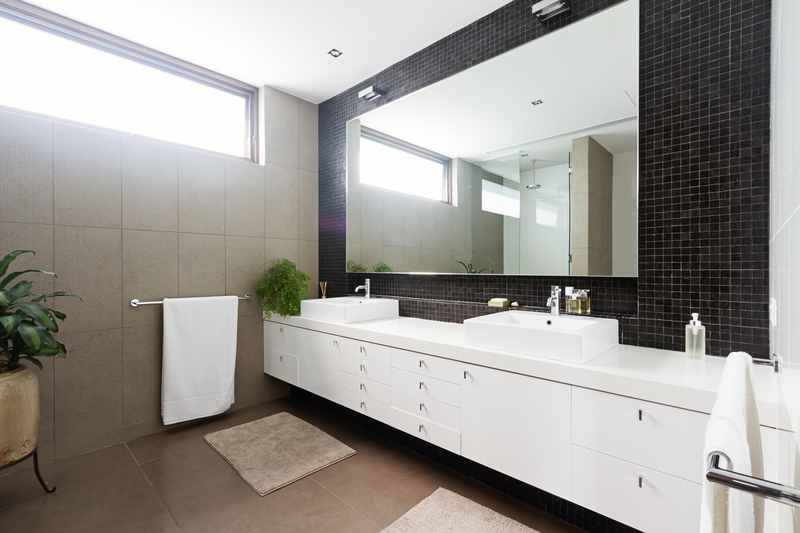Breathing Easy: Why Air Quality Matters in Residential and Commercial Spaces
Posted on 20/06/2025
Breathing Easy: Why Air Quality Matters in Residential and Commercial Spaces
Air quality plays a vital role in our overall well-being, productivity, and comfort. Whether you're at home relaxing with family or working in a bustling office, the air you breathe directly impacts your health and quality of life. While the topic often takes a backseat to other concerns, understanding indoor air quality is essential for everyone. This comprehensive guide will explore the significance of air quality in both residential and commercial environments, the potential risks of poor air, methods for improving air quality, and the long-term benefits of breathable, clean spaces.
Understanding Air Quality: More Than Just Fresh Air
When we talk about air quality, we aren't only referring to the freshness or staleness of our indoor spaces. The term encompasses a range of factors that affect the composition, cleanliness, and safety of the air we inhale every day. Indoor air quality--often abbreviated as IAQ--refers specifically to the condition of air within and around buildings, especially as it relates to the health and comfort of occupants.
Key Elements of Air Quality
- Particulate Matter (PM): Tiny particles or droplets--such as dust, pollen, soot, and smoke--that can be inhaled and cause health issues.
- Volatile Organic Compounds (VOCs): Emitted as gases from certain solids or liquids, VOCs come from paints, cleaning products, office equipment, and more.
- Biological Contaminants: Mold, bacteria, viruses, pet dander, and pollen are examples that can trigger allergies and infections.
- Carbon Dioxide (CO2): While naturally occurring, high concentrations can cause discomfort and reduce cognitive performance.
- Carbon Monoxide (CO) and Radon: Both are dangerous gases which can silently harm individuals without adequate ventilation and detection.
An understanding of these components is the first step in mitigating the risks associated with poor air quality in our living and working environments.

The Importance of Air Quality in Residential Spaces
Your home is your sanctuary, but poor indoor air quality can transform it into a source of discomfort and health hazards. The EPA has highlighted that indoor air can be several times more polluted than outdoor air. Let's explore why this happens and what it means for families and individuals.
Why Does Air Quality Deteriorate at Home?
- Insufficient Ventilation: Modern homes are built airtight to conserve energy, but this also traps pollutants inside.
- Household Products: Cleaning agents, deodorizers, and paints emit VOCs directly into the indoor air.
- Cooking and Heating: Gas stoves, fireplaces, and heating systems can release combustion pollutants and increase humidity.
- Pets and Mold: Furry family members shed dander, and moisture-heavy areas become breeding grounds for mold and mildew.
Health Risks Associated with Poor Residential Air Quality
Poor air quality in homes has been linked to several health problems, both short and long-term. These include:
- Allergic reactions and asthma exacerbations
- Headaches, fatigue, and dizziness
- Irritation of the eyes, nose, and throat
- Respiratory illnesses, such as bronchitis
- Long-term complications like heart disease, lung cancer, or reduced lung function
Children, the elderly, and individuals with pre-existing health conditions are most at risk. Ensuring good air quality at home is not just about comfort--it's a critical aspect of health and safety.
Simple Steps to Improve Home Air Quality
- Ventilate Regularly: Open windows and use exhaust fans to encourage air exchange, especially during and after cooking or cleaning.
- Use Air Purifiers: High-efficiency particulate air (HEPA) filters can capture common indoor pollutants.
- Maintain Humidity: Keep levels between 30% and 50% to prevent mold and dust mites.
- Choose Low-VOC Products: Select paints, adhesives, and cleaning products labeled as "low-VOC" or "VOC-free."
- Clean Regularly: Vacuum carpets and dust surfaces to reduce the buildup of allergens and pollutants.
Prioritize creating a healthy indoor environment by scheduling regular HVAC maintenance and testing for contaminants such as radon or carbon monoxide.
The Significance of Air Quality in Commercial Spaces
While clean air is crucial at home, it is equally--if not more--important in commercial settings. Offices, schools, shopping centers, and industrial workplaces often house large numbers of people in close proximity, making air quality management both challenging and essential for productivity and safety.
Factors Affecting Air Quality in Commercial Buildings
- Poorly Maintained Ventilation Systems: HVAC systems may spread dust or biological contaminants if not serviced regularly.
- Building Materials: Furniture, carpets, paint, and adhesives all release chemicals into the air over time.
- High Occupancy: More people means higher levels of CO2, body odor, and cross-contamination of viruses and bacteria.
- Equipment Emissions: Copiers, printers, and computers emit VOCs and other particulates.
- Moisture Problems: Leaky plumbing or roofing can create mold and mildew issues.
Impact of Air Quality on Employees and Business
- Reduced productivity, due to increased headaches, brain fog, and tiredness
- Increased absenteeism and sick leave linked to respiratory issues and infections
- Lowered morale and job satisfaction in suboptimal conditions
- Potential legal risks if regulatory requirements for indoor air quality are not met
Good air quality is not only a regulatory requirement in many jurisdictions, but also a strategic advantage for businesses striving for a healthy, thriving workforce.
Strategies for Enhancing Air Quality in Workplaces
- Routine HVAC Maintenance: Schedule regular inspections, filter changes, and duct cleaning.
- Incorporate Air Quality Sensors: Monitor levels of CO2, particulates, and VOCs in real-time.
- Ensure Adequate Ventilation: Utilize energy-efficient systems that bring in filtered outdoor air, especially in densely populated areas.
- Control Source Emissions: Choose office furniture and supplies with low chemical emissions, and maintain regulatory standards for chemical storage and usage.
- Support a Clean Environment: Implement regular cleaning protocols, pay attention to moisture control, and promote active hygiene practices among staff.
The Role of Plants in Indoor Air Quality
Indoor plants have been widely studied for their ability to improve air quality by absorbing CO2 and filtering out toxins such as benzene and formaldehyde. Adding plants to office and home environments not only contributes to better breathable air but also enhances aesthetic appeal and psychological well-being.
Common Myths and Misconceptions About Indoor Air Quality
There are several myths surrounding air quality in residential and commercial spaces that can undermine efforts to create healthier environments. Let's clarify a few:
- Myth 1: "New buildings have better air quality." Truth: Newly constructed or renovated spaces may have higher concentrations of VOCs and chemical off-gassing.
- Myth 2: "Air pollution is only an outdoor problem." Truth: Indoor air can be up to five times more polluted than outdoor air, due to poor ventilation and indoor pollution sources.
- Myth 3: "Air fresheners make the air cleaner." Truth: Most air fresheners simply mask odors and may release additional pollutants.
- Myth 4: "If you can't see or smell it, it isn't there." Truth: Many dangerous pollutants, such as carbon monoxide and radon, are colorless and odorless.
Regulatory Standards and Certifications for Indoor Air Quality
Awareness of air quality concerns has prompted governments and organizations to implement standards and guidelines for safer indoor environments. Some of the most recognized certifications and regulations include:
- ASHRAE (American Society of Heating, Refrigerating and Air-Conditioning Engineers): Provides ventilation standards for healthy indoor environments.
- EPA Indoor airPLUS: A U.S. EPA partnership program that helps builders improve indoor air quality in new homes.
- LEED Certification: The Leadership in Energy and Environmental Design program recognizes buildings with sustainable and health-oriented designs, including air quality measures.
- OSHA (Occupational Safety and Health Administration): Sets permissible exposure limits to chemicals and particulates in workplaces.
- WELL Building Standard: Focuses on features that enhance health and well-being in buildings, with indoor air as a key assessment factor.
Businesses and property managers should prioritize these standards to ensure not only regulatory compliance, but also occupant health, productivity, and satisfaction.

Emerging Technologies in Air Quality Monitoring and Filtration
Technological advances have made it easier than ever to monitor and maintain optimal air quality in both homes and commercial spaces. Here are a few innovations shaping the industry:
Smart Air Quality Monitors
Modern monitors provide real-time updates on pollutant levels, temperature, humidity, and more. Cloud-based systems can alert property owners when thresholds are breached, allowing for immediate corrective action.
Advanced Filtration and Purification
- HEPA Filters: Capture 99.97% of particles down to 0.3 microns, including pollen, dust, and some bacteria.
- Activated Carbon Filters: Excellent for absorbing VOCs and odors.
- UV-C Light Purifiers: Neutralize bacteria, viruses, and mold spores, reducing biological contaminants.
Building Management Systems (BMS)
Integrated systems can automatically adjust airflow, humidity, and filtration levels based on occupancy, time of day, and detected air quality. These systems are particularly beneficial in commercial buildings with variable usage patterns.
Conclusion: Prioritizing Air Quality for a Healthier Future
To truly breathe easy, we must recognize the importance of air quality in both our homes and workplaces. Clean, pure indoor air reduces health risks, boosts productivity, and contributes to overall happiness and well-being. Whether by implementing advanced monitoring technology, regularly maintaining ventilation systems, or adopting healthy cleaning and maintenance habits, there are numerous proactive steps we can take.
- Homeowners: Reassess cleaning routines, invest in air purification, and test for hidden dangers such as radon and carbon monoxide.
- Business owners: Maintain HVAC systems, educate employees, and comply with leading air quality standards.
- Facility managers: Integrate monitoring systems and respond promptly to air quality alerts.
Remember, air is the invisible foundation of our indoor environments. By making air quality a priority, we set the stage for healthier, happier, and more productive lives--both at home and at work.
Related Resources
- EPA Indoor Air Quality (IAQ) Resources
- ASHRAE Standards and Guidelines
- LEED Certification Standards
- OSHA Indoor Air Quality Guidance
Breathe easy--because every breath counts.




